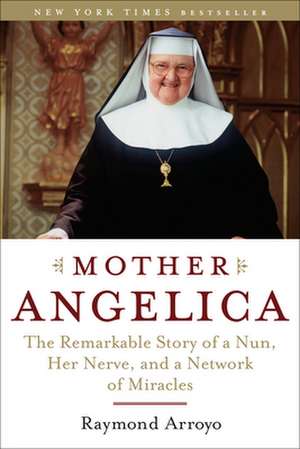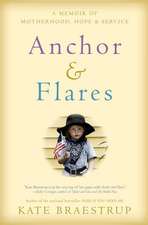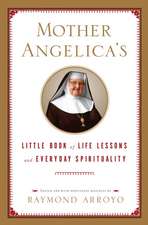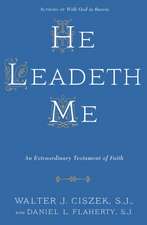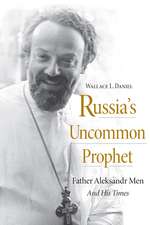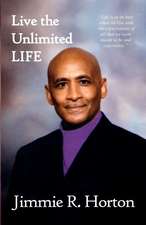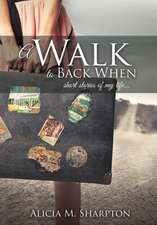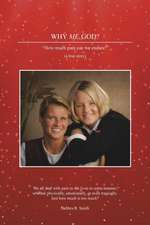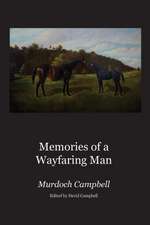Mother Angelica: The Remarkable Story of a Nun, Her Nerve, and a Network of Miracles
Autor Raymond Arroyoen Limba Engleză Paperback – 30 apr 2007
Raymond Arroyo combines his journalist’s objectivity and eye for detail with more than five years of exclusive interviews with Mother Angelica. He traces Mother Angelica’s tortured rise to success and exposes for the first time the fierce opposition she faced, both outside and inside of her church.
| Toate formatele și edițiile | Preț | Express |
|---|---|---|
| Paperback (2) | 80.91 lei 3-5 săpt. | |
| Random House – 30 oct 2018 | 80.91 lei 3-5 săpt. | |
| IMAGE – 30 apr 2007 | 114.65 lei 3-5 săpt. |
Preț: 114.65 lei
Nou
Puncte Express: 172
Preț estimativ în valută:
21.94€ • 22.86$ • 18.16£
21.94€ • 22.86$ • 18.16£
Carte disponibilă
Livrare economică 13-27 martie
Preluare comenzi: 021 569.72.76
Specificații
ISBN-13: 9780385510936
ISBN-10: 0385510934
Pagini: 384
Ilustrații: 8-PAGE BLACK AND WHITE INSERT
Dimensiuni: 145 x 210 x 23 mm
Greutate: 0.33 kg
Editura: IMAGE
ISBN-10: 0385510934
Pagini: 384
Ilustrații: 8-PAGE BLACK AND WHITE INSERT
Dimensiuni: 145 x 210 x 23 mm
Greutate: 0.33 kg
Editura: IMAGE
Notă biografică
RAYMOND ARROYO is the news director and lead anchor at EWTNews. As host of the international newsmagazine, The World Over Live, he is seen in more than 110 million households each week. Arroyo has worked at the Associated Press, the New York Observer, and for the political columnist team of Evans and Novak. His writings have appeared in the Wall Street Journal, the National Review, the Financial Times, and other publications. He has been featured on the Today show, Good Morning America, Access Hollywood, and various cable outlets, where he frequently comments on matters of culture and faith. He lives in New Orleans with his wife and three children.
Extras
1
One Miserable Life
Mother Angelica came into the world overlooked and certainly unwanted, at least by her father. She was born Rita Antoinette Rizzo in the unassuming town of Canton, Ohio, on April 20, 1923.
Aside from being the birthplace of President William McKinley, Canton was a forgotten industrial hamlet an hour or so outside of Cleveland. Great scattering streaks of brown smoke billowed from her chimney-dotted skyline, an emblem of the productivity issuing from the little town. Steel was the backbone of Canton: the building block of the new century and the lure for thousands of immigrants. From Canton's mills and production lines spilled the ball bearings, streetcars, bricks, telephones, and pipe fittings that would propel the nation into its greatest period.
Apart from the industry, Canton was, as it is today, a pleasant green pasture of rolling hills in the middle of the country, a place to raise a family and avoid the chaos and congestion of city life. That is, unless you lived in the southeast part of town, where Rita Rizzo was born.
In 1923, southeast Canton was known as the red-light district, or "the slums," according to some. For the blacks and hordes of Italian immigrants who worked in the Canton mills, the southeast was home. Italians were confined to the district by a combination of illiteracy and the constant tribute demanded by their wayward countrymen. It was a ghetto ruled by the Black Hand, a criminal organization with roots in Sicily. And though the mobsters carried black-handled revolvers as they conducted business in the neighborhood, the name Black Hand originated in the old country. Mob activity flourished during that era. A train of organized corruption ran from Cleveland to Canton to Steubenville. Cherry Street was the center of the Canton action, an avenue where racketeering joints and roving prostitutes vied for the same souls as St. Anthony's Catholic Church.
Mob slayings were a common occurrence in southeast Canton. Former members of the neighborhood still speak of people being blown up on porches, shot on street corners, or dropped in local rivers. Even today, well into their eighties, some of the locals talk of the Black Hand in muted terms and refuse permission to publish their names, for fear of reprisals.
This ethnic ghetto--where hookers tapped bordello windows to attract their johns; where shopkeepers lived across the street from female assassins; where parish priests tried to lead small-time hustlers to a better life; where the profane mingled with the sacred, and everyone struggled to make ends meet--this was the world that awaited Rita Rizzo's coming in 1923.
She was born in the sprawling home of Mary and Anthony Gianfrancesco, her maternal grandparents, who lived a block off the notorious Cherry Street. The house at 1029 Liberty was bordered on one side by an open field crawling with well-tended grapevines. Attached to the other side of the house, dominating the corner of Liberty and Eleventh streets, was Grandpa Gianfrancesco's saloon, a local watering hole and lunch spot for recently arrived immigrants and their American relations.
Rita's birth was a painful one for her mother, Mae. It took several hours and fifteen stitches to bring the nearly twelve-pound child into the world--facts Mae Gianfrancesco Rizzo never tired of repeating to her only daughter.
"My grandmother said I had rosy cheeks, a full head of hair, and was ready to go," Mother Angelica recalled with a cackle a lifetime later. "She said I looked like I was six months old."
John Rizzo, Rita's father, never wanted a child. When his wife of two years informed him she was pregnant, he "flew into a rage, violently ripping at her hair." Mae Rizzo believed this incident and the mental anguish that followed destroyed her milk supply.
When they first met, John seemed ideal to Mae. Tall, thin, dignified, he had a quiet demeanor and dressed impeccably. He wore spats and carried a cane. In a ghetto teeming with common laborers and hoodlums, John Rizzo was a dream come true. A tailor by trade, he was strolling down Eleventh Street when Mae's singing first drew him to the Gianfrancesco's kitchen door.
As Mae washed dishes, she would sing along to whatever Italian opera was spilling from her father's gramophone in the living room. Since her birth, music had always been there, as much a part of her life as Papa's saloon or the cast-iron stove in the kitchen. Mae wanted to be a singer, and she certainly had the looks for it. She was a striking woman, with dark eyes, sharp features, and an intense severity that attracted the glances of men in the neighborhood. Family photographs reveal a young woman who appreciated her good looks and knew which fashions would compliment them. Oversized hats, billowing dresses, gloves, and parasols adorned Mae's comely frame. Her beauty captivated John.
Yet for all her charms, Mae, even as a young woman, was convinced she had been cheated by life. She traced her troubles back to the fifth grade, when, during a fire drill, a male classmate took her by the hand. Whether Mae was resisting his advances or just in a foul mood, she pulled a plank from a nearby picket fence and cracked the boy over the head with it. Presumably, the teachers complained. Her mother, never one for conflict, decided that Mae had had enough education. She was removed from school and did not return. Later in life, the feeling that she didn't know enough or wasn't smart enough would leave deep scars on Mae Gianfrancesco--scars that would eventually burden her daughter.
When John Rizzo sauntered up to the kitchen door and complimented her voice, Mae must have thought him an answer to prayer. Here was a chance to escape the crowded, tempestuous household of brothers. A chance to start anew and maybe get an education. At twenty-two, Mae seized her chance at happiness and married John Rizzo on September 8, 1919, over the objections of her parents, who "never liked him."
Four years later, on September 19, 1923, the couple conveyed their five-month-old daughter, Rita Rizzo, to the font of St. Anthony's Church on Liberty Street. It was an established custom at the time to baptize infants within days of their birth, but a pair of tardy godparents had necessitated a delay. So when the Rizzos finally approached the font with the hefty child, who seemed much older than five months, the astonished priest turned to Mae. "Why didn't you wait till she could walk here?" he asked.
Freshly baptized, Rita was carried by her mother to a side altar dedicated to Our Lady of Sorrows. Surely Mae felt an affinity for this particular image of Mary. On the altar of the Madonna, whose exposed heart bore swords of anguish, Mae placed her only child. "She told me that she said, 'I give you my daughter,' " Mother Angelica remembered a bit sadly. "I'm sure she thought she would have other children, but she never did."
It is no wonder. The Rizzo marriage was already crumbling. John's inability to support the family financially seemed to be a contributing factor.
"My father could never make a decent living," Mother Angelica insisted. "Finally, my mother got him to rent a house. . . . One night I was in my crib. And I started crying, yelling, and screaming. So she got out of bed to check on me, and there were roaches everywhere, all over me, all over the wall. The wallpaper was moving. It was just full of roaches." After some choice words to John, no doubt deriding his failings as a provider, Mae bundled Rita up and went to her parents' home for the night. This would become a regular pattern throughout their marriage.
The relationship was further undermined by John Rizzo's overbearing mother, Catherine. Around 1926, Catherine Rizzo could find no domicile, despite the fact that she had eleven children, including John. So it was decided she would join the young Rizzo family in Canton--at Mae's urging.
"She didn't have enough foresight to figure out that if eleven children didn't want their mother there must be something wrong," Mother Angelica said sardonically. "So [my mother] took her in and that's when the trouble started."
In fact, the trouble probably started much earlier. John had been physically and verbally abusing Mae for years, according to court documents. So while it's unlikely that Catherine Rizzo destroyed the marriage, she certainly created flash points for the couple to war over.
The determined Mae met her equal in Grandma Rizzo. A big woman, with a mouth to match. She suffered no fools--especially in the kitchen. Grandma Rizzo's gastronomic standards were high, and Mae's cooking, as well as everything else the woman did, was just not up to par, and certainly not good enough for her son. The regular criticism became too much for an insecure person like Mae to bear.
One afternoon, Mae had just popped a chicken into the oven, bone and all--a pet peeve for Grandma Rizzo, who proudly deboned her fowl in minutes. Before the oven door had closed, the old lady began chastising Mae for her culinary short comings. Three-year-old Rita clung to her mother's side. After listening intently for several minutes, the child stepped between her mother and Grandma Rizzo.
"I said to my grandmother, 'Oh shut up. You all time talk, talk, talk.' Well, my mother grabbed me up and gave me a hundred kisses because I was defending her," Angelica recalled. "My father would never defend her!"
This would be the first, although not the last, time Rita would raise her voice in almost visceral defense of her mother. It is also the first glimpse of the outspoken quality that would come to define her character. But the intervention did little to quell the acrimony between Mae and her mother-in-law.
Sometime between 1927 and 1928, according to Mother Angelica, a possessed Mae climbed the stairs of their home in search of a gun to kill the old woman. "If my father's mother had been there, she would have done it. Luckily, she had left for Reading, Pennsylvania, to live with her daughter . . ."
By November of 1928, John Rizzo was also living elsewhere. For two years, he lost himself in California, providing no explanation and no forwarding address. Without money or a job, Mae had to support what was left of her family. Like refugees, she and five-year-old Rita returned to her parents' home though. They were not exactly welcome there. The Gianfrancesco home was already filled to capacity. Mae's four brothers (Tony, Pete, Frank, and Nick) and the elder Gianfrancescos occupied the two bedrooms, forcing Rita and Mae to sleep in a renovated attic. Over the years, Mother Angelica often told a story about that first winter in the house. As she and her mother slept in the upper room, a storm blew open the windows, depositing snow on top of them. Given the resources and generosity of the Gianfrancescos during this period, it seems odd that they would subject their own daughter and grandchild to such brutal conditions.
Anthony Gianfrancesco was far from poor, despite the poverty around him. He owned three homes in the neighborhood, which he rented to family and to Canton's newly arrived Italian immigrants at cut-rate prices. Anthony had emigrated from Naples, Italy, to Colorado, where he worked in a gold mine, before moving to Akron, Ohio. There he met and married Mary Votolato. Conflicts with his mother-in-law spurred a resettling in Canton and a new business venture.
The saloon bearing Anthony Gianfrancesco's name became a safe harbor for foreign families afloat in a strange new land. In southeast Canton, the saloon was the center of Italian public life, a place where countrymen could speak their native tongue, mingle with their own, and share the indignities endured that day at the hands of the Americans. Mother Angelica remembered her grandfather providing Italian newcomers with clothes and helping them find work. Grandma Gianfrancesco would often feed the immigrant families in a room above the saloon, where the Italian lodges would sometimes meet. It was a family place. Inebriation was forbidden, and if the tab got too high or the hour too late, the Gianfrancescos would send their customers home.
It is likely that hard liquor or beer was served in the Gianfrancesco establishment during Prohibition, which hit Canton on January 16, 1920, and would not be repealed until February 1933. Mother Angelica vividly recalled one event that happened in either 1929 or 1930.
"I couldn't have been more than four or five, and my grandfather didn't want me in the saloon. He gave me a small mug of beer with a big collar on it. I had four or five pretzels, and he said, 'Go outside and sit on the curb and enjoy yourself.' So I'm out there on the curb drinking this beer and eating pretzels when the Salvation Army Band shows up. Well, they're praying all kinds of psalms in front of me and praying for my salvation. They must have been shocked to see this kid drinking beer. I remember yelling up to my grandfather, 'There's a big band down here.' "
The little girl with the Buster Brown haircut had a front-row seat on life unvarnished. At the corner of Liberty and Eleventh streets, she observed the people and the ways of the world, not all of them as benign as the passing Salvation Army Band. On her curbside outings, she would converse with prostitutes, members of the mob, men returning from the mills, Mamooch--an Italian woman who roamed the streets, praying--and the black people who shared her neighborhood. This moving carousel of humanity would instill within the child an empathy for strangers and teach her to relate easily with individuals from disparate backgrounds. In this laboratory of life, young Rita absorbed the misery of the world and the hidden humor few ever managed to find.
About this time, Mae Rizzo set up a dry-cleaning shop next to her father's saloon, after a brief apprenticeship with a tailor and cleaner. It would be the first of many entrepreneurial efforts she undertook to provide for Rita without family assistance. If she had to live beneath her parents' roof, Mae was determined to show them she could support her daughter--alone.
From the Hardcover edition.
One Miserable Life
Mother Angelica came into the world overlooked and certainly unwanted, at least by her father. She was born Rita Antoinette Rizzo in the unassuming town of Canton, Ohio, on April 20, 1923.
Aside from being the birthplace of President William McKinley, Canton was a forgotten industrial hamlet an hour or so outside of Cleveland. Great scattering streaks of brown smoke billowed from her chimney-dotted skyline, an emblem of the productivity issuing from the little town. Steel was the backbone of Canton: the building block of the new century and the lure for thousands of immigrants. From Canton's mills and production lines spilled the ball bearings, streetcars, bricks, telephones, and pipe fittings that would propel the nation into its greatest period.
Apart from the industry, Canton was, as it is today, a pleasant green pasture of rolling hills in the middle of the country, a place to raise a family and avoid the chaos and congestion of city life. That is, unless you lived in the southeast part of town, where Rita Rizzo was born.
In 1923, southeast Canton was known as the red-light district, or "the slums," according to some. For the blacks and hordes of Italian immigrants who worked in the Canton mills, the southeast was home. Italians were confined to the district by a combination of illiteracy and the constant tribute demanded by their wayward countrymen. It was a ghetto ruled by the Black Hand, a criminal organization with roots in Sicily. And though the mobsters carried black-handled revolvers as they conducted business in the neighborhood, the name Black Hand originated in the old country. Mob activity flourished during that era. A train of organized corruption ran from Cleveland to Canton to Steubenville. Cherry Street was the center of the Canton action, an avenue where racketeering joints and roving prostitutes vied for the same souls as St. Anthony's Catholic Church.
Mob slayings were a common occurrence in southeast Canton. Former members of the neighborhood still speak of people being blown up on porches, shot on street corners, or dropped in local rivers. Even today, well into their eighties, some of the locals talk of the Black Hand in muted terms and refuse permission to publish their names, for fear of reprisals.
This ethnic ghetto--where hookers tapped bordello windows to attract their johns; where shopkeepers lived across the street from female assassins; where parish priests tried to lead small-time hustlers to a better life; where the profane mingled with the sacred, and everyone struggled to make ends meet--this was the world that awaited Rita Rizzo's coming in 1923.
She was born in the sprawling home of Mary and Anthony Gianfrancesco, her maternal grandparents, who lived a block off the notorious Cherry Street. The house at 1029 Liberty was bordered on one side by an open field crawling with well-tended grapevines. Attached to the other side of the house, dominating the corner of Liberty and Eleventh streets, was Grandpa Gianfrancesco's saloon, a local watering hole and lunch spot for recently arrived immigrants and their American relations.
Rita's birth was a painful one for her mother, Mae. It took several hours and fifteen stitches to bring the nearly twelve-pound child into the world--facts Mae Gianfrancesco Rizzo never tired of repeating to her only daughter.
"My grandmother said I had rosy cheeks, a full head of hair, and was ready to go," Mother Angelica recalled with a cackle a lifetime later. "She said I looked like I was six months old."
John Rizzo, Rita's father, never wanted a child. When his wife of two years informed him she was pregnant, he "flew into a rage, violently ripping at her hair." Mae Rizzo believed this incident and the mental anguish that followed destroyed her milk supply.
When they first met, John seemed ideal to Mae. Tall, thin, dignified, he had a quiet demeanor and dressed impeccably. He wore spats and carried a cane. In a ghetto teeming with common laborers and hoodlums, John Rizzo was a dream come true. A tailor by trade, he was strolling down Eleventh Street when Mae's singing first drew him to the Gianfrancesco's kitchen door.
As Mae washed dishes, she would sing along to whatever Italian opera was spilling from her father's gramophone in the living room. Since her birth, music had always been there, as much a part of her life as Papa's saloon or the cast-iron stove in the kitchen. Mae wanted to be a singer, and she certainly had the looks for it. She was a striking woman, with dark eyes, sharp features, and an intense severity that attracted the glances of men in the neighborhood. Family photographs reveal a young woman who appreciated her good looks and knew which fashions would compliment them. Oversized hats, billowing dresses, gloves, and parasols adorned Mae's comely frame. Her beauty captivated John.
Yet for all her charms, Mae, even as a young woman, was convinced she had been cheated by life. She traced her troubles back to the fifth grade, when, during a fire drill, a male classmate took her by the hand. Whether Mae was resisting his advances or just in a foul mood, she pulled a plank from a nearby picket fence and cracked the boy over the head with it. Presumably, the teachers complained. Her mother, never one for conflict, decided that Mae had had enough education. She was removed from school and did not return. Later in life, the feeling that she didn't know enough or wasn't smart enough would leave deep scars on Mae Gianfrancesco--scars that would eventually burden her daughter.
When John Rizzo sauntered up to the kitchen door and complimented her voice, Mae must have thought him an answer to prayer. Here was a chance to escape the crowded, tempestuous household of brothers. A chance to start anew and maybe get an education. At twenty-two, Mae seized her chance at happiness and married John Rizzo on September 8, 1919, over the objections of her parents, who "never liked him."
Four years later, on September 19, 1923, the couple conveyed their five-month-old daughter, Rita Rizzo, to the font of St. Anthony's Church on Liberty Street. It was an established custom at the time to baptize infants within days of their birth, but a pair of tardy godparents had necessitated a delay. So when the Rizzos finally approached the font with the hefty child, who seemed much older than five months, the astonished priest turned to Mae. "Why didn't you wait till she could walk here?" he asked.
Freshly baptized, Rita was carried by her mother to a side altar dedicated to Our Lady of Sorrows. Surely Mae felt an affinity for this particular image of Mary. On the altar of the Madonna, whose exposed heart bore swords of anguish, Mae placed her only child. "She told me that she said, 'I give you my daughter,' " Mother Angelica remembered a bit sadly. "I'm sure she thought she would have other children, but she never did."
It is no wonder. The Rizzo marriage was already crumbling. John's inability to support the family financially seemed to be a contributing factor.
"My father could never make a decent living," Mother Angelica insisted. "Finally, my mother got him to rent a house. . . . One night I was in my crib. And I started crying, yelling, and screaming. So she got out of bed to check on me, and there were roaches everywhere, all over me, all over the wall. The wallpaper was moving. It was just full of roaches." After some choice words to John, no doubt deriding his failings as a provider, Mae bundled Rita up and went to her parents' home for the night. This would become a regular pattern throughout their marriage.
The relationship was further undermined by John Rizzo's overbearing mother, Catherine. Around 1926, Catherine Rizzo could find no domicile, despite the fact that she had eleven children, including John. So it was decided she would join the young Rizzo family in Canton--at Mae's urging.
"She didn't have enough foresight to figure out that if eleven children didn't want their mother there must be something wrong," Mother Angelica said sardonically. "So [my mother] took her in and that's when the trouble started."
In fact, the trouble probably started much earlier. John had been physically and verbally abusing Mae for years, according to court documents. So while it's unlikely that Catherine Rizzo destroyed the marriage, she certainly created flash points for the couple to war over.
The determined Mae met her equal in Grandma Rizzo. A big woman, with a mouth to match. She suffered no fools--especially in the kitchen. Grandma Rizzo's gastronomic standards were high, and Mae's cooking, as well as everything else the woman did, was just not up to par, and certainly not good enough for her son. The regular criticism became too much for an insecure person like Mae to bear.
One afternoon, Mae had just popped a chicken into the oven, bone and all--a pet peeve for Grandma Rizzo, who proudly deboned her fowl in minutes. Before the oven door had closed, the old lady began chastising Mae for her culinary short comings. Three-year-old Rita clung to her mother's side. After listening intently for several minutes, the child stepped between her mother and Grandma Rizzo.
"I said to my grandmother, 'Oh shut up. You all time talk, talk, talk.' Well, my mother grabbed me up and gave me a hundred kisses because I was defending her," Angelica recalled. "My father would never defend her!"
This would be the first, although not the last, time Rita would raise her voice in almost visceral defense of her mother. It is also the first glimpse of the outspoken quality that would come to define her character. But the intervention did little to quell the acrimony between Mae and her mother-in-law.
Sometime between 1927 and 1928, according to Mother Angelica, a possessed Mae climbed the stairs of their home in search of a gun to kill the old woman. "If my father's mother had been there, she would have done it. Luckily, she had left for Reading, Pennsylvania, to live with her daughter . . ."
By November of 1928, John Rizzo was also living elsewhere. For two years, he lost himself in California, providing no explanation and no forwarding address. Without money or a job, Mae had to support what was left of her family. Like refugees, she and five-year-old Rita returned to her parents' home though. They were not exactly welcome there. The Gianfrancesco home was already filled to capacity. Mae's four brothers (Tony, Pete, Frank, and Nick) and the elder Gianfrancescos occupied the two bedrooms, forcing Rita and Mae to sleep in a renovated attic. Over the years, Mother Angelica often told a story about that first winter in the house. As she and her mother slept in the upper room, a storm blew open the windows, depositing snow on top of them. Given the resources and generosity of the Gianfrancescos during this period, it seems odd that they would subject their own daughter and grandchild to such brutal conditions.
Anthony Gianfrancesco was far from poor, despite the poverty around him. He owned three homes in the neighborhood, which he rented to family and to Canton's newly arrived Italian immigrants at cut-rate prices. Anthony had emigrated from Naples, Italy, to Colorado, where he worked in a gold mine, before moving to Akron, Ohio. There he met and married Mary Votolato. Conflicts with his mother-in-law spurred a resettling in Canton and a new business venture.
The saloon bearing Anthony Gianfrancesco's name became a safe harbor for foreign families afloat in a strange new land. In southeast Canton, the saloon was the center of Italian public life, a place where countrymen could speak their native tongue, mingle with their own, and share the indignities endured that day at the hands of the Americans. Mother Angelica remembered her grandfather providing Italian newcomers with clothes and helping them find work. Grandma Gianfrancesco would often feed the immigrant families in a room above the saloon, where the Italian lodges would sometimes meet. It was a family place. Inebriation was forbidden, and if the tab got too high or the hour too late, the Gianfrancescos would send their customers home.
It is likely that hard liquor or beer was served in the Gianfrancesco establishment during Prohibition, which hit Canton on January 16, 1920, and would not be repealed until February 1933. Mother Angelica vividly recalled one event that happened in either 1929 or 1930.
"I couldn't have been more than four or five, and my grandfather didn't want me in the saloon. He gave me a small mug of beer with a big collar on it. I had four or five pretzels, and he said, 'Go outside and sit on the curb and enjoy yourself.' So I'm out there on the curb drinking this beer and eating pretzels when the Salvation Army Band shows up. Well, they're praying all kinds of psalms in front of me and praying for my salvation. They must have been shocked to see this kid drinking beer. I remember yelling up to my grandfather, 'There's a big band down here.' "
The little girl with the Buster Brown haircut had a front-row seat on life unvarnished. At the corner of Liberty and Eleventh streets, she observed the people and the ways of the world, not all of them as benign as the passing Salvation Army Band. On her curbside outings, she would converse with prostitutes, members of the mob, men returning from the mills, Mamooch--an Italian woman who roamed the streets, praying--and the black people who shared her neighborhood. This moving carousel of humanity would instill within the child an empathy for strangers and teach her to relate easily with individuals from disparate backgrounds. In this laboratory of life, young Rita absorbed the misery of the world and the hidden humor few ever managed to find.
About this time, Mae Rizzo set up a dry-cleaning shop next to her father's saloon, after a brief apprenticeship with a tailor and cleaner. It would be the first of many entrepreneurial efforts she undertook to provide for Rita without family assistance. If she had to live beneath her parents' roof, Mae was determined to show them she could support her daughter--alone.
From the Hardcover edition.
Recenzii
ADVANCE PRAISE FOR MOTHER ANGELICA
“In this dramatic page-turner, Raymond Arroyo has captured the life and lessons of Mother Angelica, a woman who may well be the patron saint of CEOs. Buy this book and be inspired.”
—Lee Iacocca, The Iacocca Foundation, former chief executive officer of the Chrysler Corporation
“Raymond Arroyo masterfully captures the complexities, humanity, and tenacity of Mother Angelica, who has long been one of my own personal heroes. The founder of the Eternal Word Television Network, Mother Angelica is a woman who dared to dream, to stand up for what she believed in, and whose faith showed that anything is possible. In Arroyo’s hands, she becomes someone you wish you had the opportunity to know and love. Read this book and believe.”
—Nicholas Sparks
“This is some woman. What a wonderful story Raymond Arroyo has written—wonderful because it’s true, because he got the facts, because she chose him to tell them, and because he’s a born storyteller.”
—Peggy Noonan, author of When Character Was King
“Mother Angelica’s personal words to me, her courageous example, and her constant prayers helped inspire my portrayal of Jesus in The Passion of the Christ. No one could have captured the essence of this modern-day saint better than Raymond Arroyo. His narrative gifts and understanding of Mother are clearly evident in this truthful and often candid depiction of one nun’s struggle to bring God to the multitudes. Surely this book, and Mother’s life will have an incredible enduring legacy.”
—James Caviezel, actor
“Mother Angelica is one of the greatest entrepreneurs of all time, and is truly one of my heroes. With his “insider” perspective, Raymond Arroyo has done a masterful job capturing not only Mother’s immeasurable accomplishments but also her remarkable personality. Like Mother herself, this book has the unique combination of being both inspiring and entertaining.”
—Thomas S. Monaghan, founder of Domino’s Pizza and Chancellor of Ave Maria University
“A rattling good story of fear, faith, courage, and bulldog tenacity, beautifully told. The drama of Mother Angelica’s life is a powerful reminder that the extraordinary lies just beyond the ordinary—if we have eyes to see and ears to hear.”
—George Weigel, author of Witness to Hope:Tthe Biography of Pope John Paul II
“In this dramatic page-turner, Raymond Arroyo has captured the life and lessons of Mother Angelica, a woman who may well be the patron saint of CEOs. Buy this book and be inspired.”
—Lee Iacocca, The Iacocca Foundation, former chief executive officer of the Chrysler Corporation
“Raymond Arroyo masterfully captures the complexities, humanity, and tenacity of Mother Angelica, who has long been one of my own personal heroes. The founder of the Eternal Word Television Network, Mother Angelica is a woman who dared to dream, to stand up for what she believed in, and whose faith showed that anything is possible. In Arroyo’s hands, she becomes someone you wish you had the opportunity to know and love. Read this book and believe.”
—Nicholas Sparks
“This is some woman. What a wonderful story Raymond Arroyo has written—wonderful because it’s true, because he got the facts, because she chose him to tell them, and because he’s a born storyteller.”
—Peggy Noonan, author of When Character Was King
“Mother Angelica’s personal words to me, her courageous example, and her constant prayers helped inspire my portrayal of Jesus in The Passion of the Christ. No one could have captured the essence of this modern-day saint better than Raymond Arroyo. His narrative gifts and understanding of Mother are clearly evident in this truthful and often candid depiction of one nun’s struggle to bring God to the multitudes. Surely this book, and Mother’s life will have an incredible enduring legacy.”
—James Caviezel, actor
“Mother Angelica is one of the greatest entrepreneurs of all time, and is truly one of my heroes. With his “insider” perspective, Raymond Arroyo has done a masterful job capturing not only Mother’s immeasurable accomplishments but also her remarkable personality. Like Mother herself, this book has the unique combination of being both inspiring and entertaining.”
—Thomas S. Monaghan, founder of Domino’s Pizza and Chancellor of Ave Maria University
“A rattling good story of fear, faith, courage, and bulldog tenacity, beautifully told. The drama of Mother Angelica’s life is a powerful reminder that the extraordinary lies just beyond the ordinary—if we have eyes to see and ears to hear.”
—George Weigel, author of Witness to Hope:Tthe Biography of Pope John Paul II
Descriere
This is the extraordinary saga of a cloistered nun who used her instincts and $200 to launch the world's first Catholic cable channel. What began in the garage of an Alabama monastery is now the Eternal World Television Network, reaching more than 184 million viewers worldwide.
